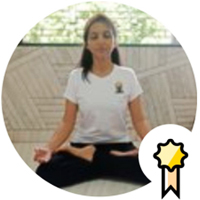![]()
300 Hour Teacher Training
Why Join Shiva Rishi Yoga For The 300 Hour Teacher Training ? How Is The 300 Hour Different From The 200 Hour ?
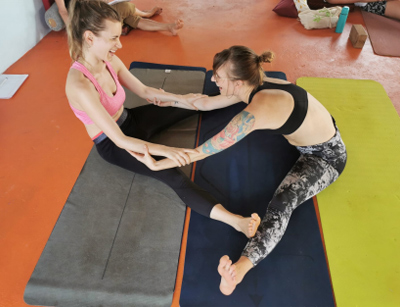 A 300 hour training is for those highly devoted to the path of yoga. The extended time at the ashram allow the time and space for a more organic unfolding of the teachings. Some schools offer a 300 hour program in 28 days; however, this is just a business model, that shortchanges the students with a rushed, stressed, less developed training experience. In more compressed programs, students often leave with unanswered questions and are unprepared to teach. Providing us a longer duration for the course allows more time for student-teacher interaction; student-student learning; and overall building a strong, experienced, and knowledgeable yoga community. At Shiva Rishi, we feel you are a part of our family, not just a student.
A 300 hour training is for those highly devoted to the path of yoga. The extended time at the ashram allow the time and space for a more organic unfolding of the teachings. Some schools offer a 300 hour program in 28 days; however, this is just a business model, that shortchanges the students with a rushed, stressed, less developed training experience. In more compressed programs, students often leave with unanswered questions and are unprepared to teach. Providing us a longer duration for the course allows more time for student-teacher interaction; student-student learning; and overall building a strong, experienced, and knowledgeable yoga community. At Shiva Rishi, we feel you are a part of our family, not just a student.
With the added training time, we explore yoga’s ancient, sacred roots. We focus not only on the physical postures, but how the postures evolved. We also take excursions together; have group meditations and kirtans; have Ayurvedic cooking classes; massages; student teaching observation and ample learning time; Creative sequencing, yogic mythology, Tantric Buddhism meditation and Mudra; Yogic history, duality vs. non-duality; Confidence-building through practice teaching; Ethics, the business of yoga, finding your unique voice, teacher qualities; guided relaxation techniques (yoga Nidra); a deeper look into injuries and physical limitations; informed use of props to improve or modify a posture; spiritual guidance; and more. At the end of the 300 hour program, you will feel a sense of santosha from participating in a very integrative, holistic yoga program – you may not want to go home!
- Ancient techniques of classical hatha yoga combined with vinyasa flow in a unique and authentic way active life, this teacher training will help you to define the best way for Yoga to integrate with your life.
- Asana: You will be immersed in a daily practice as well as practical sessions which focus on standing poses, forward bends, twists, backbends, inversions and balances, in-depth exploration of vinyasa, sequencing, and alignment.
- Learn how to give hands on assists to students while they are practicing asanas.
- Sanskrit language immersion—you will learn to recite, read and write the Sanskrit alphabet as well as an exploration into the major yogic texts and sutras to broaden your understanding of renowned spiritual teachings: The Yoga Sutra of Patanjali, The Upanishad, The Bhagavad Gita, The Hatha Yoga Pradipika, Vedanta, and Samkaya Yoga.
- Sanskrit language immersion—you will learn to recite, read and write the Sanskrit alphabet as well as an exploration into the major yogic texts and sutras to broaden your understanding of renowned spiritual teachings: The Yoga Sutra of Patanjali, The Upanishad, The Bhagavad Gita, The Hatha Yoga Pradipika, Vedanta, and Samkaya Yoga.
- Meditation: You will learn to meditate and practice meditation twice a day as well as learn how to teach meditation to others.
- Practice and teach healing, purifying, and detoxifying hatha yoga kriyas.
- Learn the importance of a vegetarian and vegan diet in regards to human health, sustaining the eco-system, reducing violence in the world (ahimsa) as a means to enlightenment.
- Understand physical and energetic anatomy of the human body.
- Philosophy, ethics and activism: how to live a more effective and positive life.
- Practice teaching: at the end of this training you will have the skill to teach yoga classes right away.
- Practice of Bakti Yoga, Bhajans, mantras, and mudras.
- Basic knowledge of Ayurveda gives you a holistic view of disease prevention and proper lifestyle choices, as well as a complete understanding of subtle anatomy and its relationship to the cosmos. You will learn how the mind influences the body structure and to “body read.” Ayurvedic approaches to yoga add a new degree of awareness. Teachers learn to adjust a practice to serve different body types and constitutions (Vata, Pitta, Kapha).
- Anatomy and physiology: basics of skeletal, muscular, respiratory, nervous and cardiovascular systems; injury and recovery; esoteric anatomy, including chakras, nadis, prana, granthi, and bandha.
- Group Practicum: Includes class observation focusing on adjustment, sequencing, and giving you materials to study and practice with other students in your free time.
- Spiritual Day Trips to nearby places such as Golden Temple; jungle waterfall. Also explore the many diverse landscapes of Kerala like the backwaters, hills, and hidden beaches.
We welcome you with great respect and love
What is included in the Course Fees ?
- 32 nights shared or private Accommodation
- Free Pickup From Trivandrum Airport
- 3 Times daily nutritious vegetarian meals and herbal tea
- 2 Ayurvedic Massage
- Training Manuals PDF files Textbooks, & study material
- Full support during your stay at the ashram
- Theoretical and practical skills
- WIFI access room
- Weekend excursions to Kapil beach; the river; hiking in the jungle; golden island all included
- Kirtan, mantra, Bhajan
- Drinking water, toilet Paper and fruits are Provided on arrival of School, available 24×7
- Zero waste kit with bottle, bag, toothbrush & cutlery all eco-friendly, supporting local business and environment
- Attached bathrooms
- Both running Hot and Cold water
- Free Wi-Fi
- 24 hour running water
- CCTV Security
- We strive to be a zero waste facility. Please leave plastic at home if possible. We also have a small garden on site if you would like to enjoy some gardening meditation.


Course Fees Does Not Include:
- Travel expenses (i.e. airfare, train, bus, taxi, camel, etc.)
- Laundry services (available at additional charges)
- Extra nights beyond course dates (*available at additional charges; longer stays for study can be arranged)
- Extra excursion not organized by school
- Air Conditioning / Heater (available at additional charges)
- Travel Insurance
- Medical Expenses
- Other Personal Expenses
![]()
Course Curriculum
This 300-Hour course is the foundation for learning Yoga Postures with correct postures and alignment. We work to support you as an effective Yoga Asana Teacher, providing you all the basic knowledge, skills and confidence to continue to teach and share this priceless knowledge.
I. Asanas
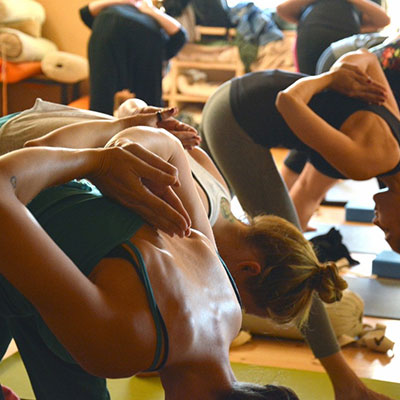 Asana is the third limb of yoga, one of the many components that make a healthy and balanced yogi. We focus on Classical Hatha Yoga and Vinyasa Kriya Yoga. Shiva can help you master the benefits of asanas for your life, as well as move beyond the asanas to higher awareness and conncetion.
Asana is the third limb of yoga, one of the many components that make a healthy and balanced yogi. We focus on Classical Hatha Yoga and Vinyasa Kriya Yoga. Shiva can help you master the benefits of asanas for your life, as well as move beyond the asanas to higher awareness and conncetion.
The body we have today is nothing but the accumulation of our past thoughts, emotions, and actions. In fact our body is the crystallized history of our past thoughts. This needs to be deeply understood and contemplated. It means that asana is the method that releases us from past conditioning, stored in the body, to arrive in the present moment. Many obstacles to knowing one’s true nature are manifested in the body, for example disease, sluggishness, and dullness. The body profoundly influences and, if in bad condition, impinges on the functioning of mind and intellect. Asana is an invitation to say goodbye to these extremes and arrive at the truth of the present moment.
Our Soul Passes 8.4 Million births to arrive into this precious human body, this was the wisdom shared in the Bhagavad Gita, by Lord Sri Krishna to Arjuna. After so many births, this is a very special opportunity in this human body for our soul. The Bhagavad Gita continues (2.22) and says that, ‘just as one gives up an old shirt to put on a new one, the soul gives up an old body to acquire a new kind of body’ (vasāmsi jirnāni yathā vihāya). Thus, there are 8.4 million (84 lakh) types of bodies, out of which the soul assumes a body at the time of death. As a reflection and representation of these 84 lakh incarnations, the Hatha Yoga Pradipika (15th century) specifies 84 asanas. The first four are the most important for meditation: Siddhasana, Padmasana, Bhadrasana and Simhasana.
II. Deeper Spiritual Practice Of Yoga ~ PRANAYAMA, SWARA YOGA, MEDITATION & YOGA NIDRA
i. Pranayama
 Pranayama in Sanskrit literally translates to, “extension of the prana or breath.” Prana means life-force and it is the vital energy or life-force that pervades the body. Prana is the spiritual link between the mind and consciousness. Pranayama assists in purifying the blood; reducing anxiety and stress levels; clearing negative emotions; addressing repressed anger; removing toxins and preventing disease; and strengthening the immune system.
Pranayama in Sanskrit literally translates to, “extension of the prana or breath.” Prana means life-force and it is the vital energy or life-force that pervades the body. Prana is the spiritual link between the mind and consciousness. Pranayama assists in purifying the blood; reducing anxiety and stress levels; clearing negative emotions; addressing repressed anger; removing toxins and preventing disease; and strengthening the immune system.
Breathing is the one steady truth we have as a whole, universally. Without breath, there is no life; yet we scarcely focus on our breath, in general day-to-day errands.
The journey of yoga through pranayama, asana, yoga nidra, and meditation is a process for decoding the self, and one’s relationship the world. Through the practices of mind-body health, one can enhance, expand, and accelerate optimal states of energy and consciousness.
ii. Shiva Swarodaya or Swara Yoga
 Swara yoga has been expounded by our guru swami Satyananda Saraswati, also termed the “sound of one’s own breath,” and is a mode of analyzing and practicing breathwork. The original discussion on this topic is written as a conversation between Shiva and Parvati. This ancient scripture has 395 sutras. Through the knowledge of Swara yoga one can become free from all kinds of negative influences of one’s destiny and can achieve heightened awareness. Also, it was useful for the Grahastha, the householder, as it is useful for initiating action in day-to-day matters. This may include waking up, eating, bathing and studying. Swara yoga is an ancient science existing before the Vedic period, over ten or fifteen thousand years ago. It was a secret science, only available for the select few, especially kings and dedicated sadhaks. It was kept as a closed secret by the ancient sages and saints who had intuitively received this knowledge from the Divine. It was used for those who had mental, physical, emotional, and spiritual problems so that they could get rid of their problems by using this divine knowledge of Swara Yoga.
Swara yoga has been expounded by our guru swami Satyananda Saraswati, also termed the “sound of one’s own breath,” and is a mode of analyzing and practicing breathwork. The original discussion on this topic is written as a conversation between Shiva and Parvati. This ancient scripture has 395 sutras. Through the knowledge of Swara yoga one can become free from all kinds of negative influences of one’s destiny and can achieve heightened awareness. Also, it was useful for the Grahastha, the householder, as it is useful for initiating action in day-to-day matters. This may include waking up, eating, bathing and studying. Swara yoga is an ancient science existing before the Vedic period, over ten or fifteen thousand years ago. It was a secret science, only available for the select few, especially kings and dedicated sadhaks. It was kept as a closed secret by the ancient sages and saints who had intuitively received this knowledge from the Divine. It was used for those who had mental, physical, emotional, and spiritual problems so that they could get rid of their problems by using this divine knowledge of Swara Yoga.
iii. Meditation techniques
- What is meditation and why it’s practiced – meditation as Kriya
- Various meditation techniques and tools
- Quieting the mind to develop deeper levels of awareness
- Connecting with nature and the world you live in
- Connecting with the true Self

It’s been widely agreed by the Masters, that our focus creates our reality. The quality of our thoughts determines the quality of our lives. While many seek first to improve the outer conditions of their lives in order to find peace, the truly wise have turned inward, to improve the inner environment, and purify their mental landscape. When we are able to master our mind (using yoga and meditation), everything becomes easier. Our mind becomes clearer and more focused, we feel more in harmony with our emotions, and we create mental space for ourselves, which melts stress and puts us firmly in the driver’s seat of our lives.
iv. Yoga Nidra
 Yoga Nidra is a practice of deep shavasana like meditation. In the practice one deeply relaxes the body, allowing karmic patterns to come out and be resolved when practiced regularly. In yoga Nidra, one also releases the stress of the day; releases tight muscles; it is all effortless, and yet extremely beneficial for the physical, subtle, and spiritual body.
Yoga Nidra is a practice of deep shavasana like meditation. In the practice one deeply relaxes the body, allowing karmic patterns to come out and be resolved when practiced regularly. In yoga Nidra, one also releases the stress of the day; releases tight muscles; it is all effortless, and yet extremely beneficial for the physical, subtle, and spiritual body.
III. Yoga Philosophy & Lifestyle Ethics
A yogic lifestyle is a journey to create unity on all levels. This means to live every day consciously, with a focused, calm mind, seeking inner harmony at all times.
This teacher training places an emphasis on studying the vast heritage of yoga philosophy. By introducing the Samkhya system of evolution and discuss traditional texts (such as the Yoga Sutras by Patanjali) we explore the eight limbs of Ashtanga Yoga in detail and take a glimpse beyond the first limbs towards the ultimate goal of yoga. Next to getting inspiration from these sacred texts, we recognize the importance of a firm foundation in the first limbs, as prerequisite to progress on this path of liberation -and how you, as prospective yoga teachers, can assist other beings along this journey.
With our students, we look forward to inspiring conversations about the precept of non-violence (ahimsa), the concepts of dharma and karma, and finally the value of teaching yoga while being of service to others (seva).
Ancient Yoga Technique For Attaining Mastery Over The Mind
- The four paths of yoga: Karma, Bhakti, Raja, Jnana
- Vedanta and Samkhya Philosophy Yoga Sutras of Patanjali – the study of the text and commentary
- Bhagavad Gita – the study of the text and commentary
- Samkhya and Tantric philosophy
- Basic concepts of Vedanta philosophy
- Subtle anatomy: Prana, Nadis, Chakras, Bandha
- Nutrition and diet for the yogis
- Consciously living as a modern yogi
- Behavioral psychology
- Non-violent communication; eliminate drama in one’s life; work through your complexes.
- Learn the importance of living, not just in the physical world but also in the spiritual world. And how you can function in duality to transform every aspect of your life.
- Unlock your creativity
- Powerful tools for stress management
- Reduce anxiety and depression; sleep better than you have in years
- Experience true happiness, peace, and contentment
- Gain greater clarity, focus, and presence
- Have more energy throughout the day
- Dissolve negative beliefs and thought patterns
- Understand (and overcome) addictive patterning
Yoga Lifestyle For Stopping Stress and Other Afflictions
Feeling sad? Sit in Lotus. Better yet, rise up into a backbend, forward bend, or headstand. While it’s not as simple as that, one study found that a consistent yoga practice. The process of performing yoga practice is claimed to lead to a certain purification of the blood, which frees up the life force to flow along the spine. “Yoga is a simple, psycho-physiological method by which the human blood is decarbonized and recharged with oxygen. The atoms of this extra oxygen are transmuted into life current to rejuvenate the brain and spinal centers, by stopping things like stress and emotional pain — usually caused by bad memories, old programming, emotions, and/or overthinking.” Improving your Anahata chakra, for instance, controls the love energy in the body. On a physical level, the heart chakra responds to the heart, lungs, immune system, and muscles of the upper body. On a spiritual level, opening the heart chakra fills you with love, forgiveness, and compassion. If yoga can do one thing, it should make you happier and thus by default, healthier.
Zero Waste & A Conscious Lifestyle
The yogi works to unify mind, body, spirit, and environment. We support healthy, organic, non-wasteful lifestyles. We encourage you to be mindful of your impact on the planet and how you can contribute to the awareness of your students. Here at the ashram, we will provide you with reusable water bottle and refill station, so you do not need to purchase bottled water. We strive to minimize our waste footprint in this beautiful area of Kerala. Please refrain from single-use plastics and be mindful of this when you enjoy the surrounding area. We will also give you a simple utensil set so you can have your own travel cutlery and straw. To take care of the planet is ahimsa, to be aware of the suffering of the world and doing one’s part to take corrective actions is living the path of satya.
IV. Ayurveda
Ayurveda is the science of living. Our practice depends on us being in balance. Through an understanding of Ayurveda, we learn about our bodily constitution and temperaments, and what kind of lifestyle and diet can help bring us balance. Our Ayurvedic Doctor will teach you about the theoretical basics of Ayurveda, helping you to discover a diet fitting to your type of body. Through Ayurveda we can understand the positive effects of the high qualitative sattvic yogi diet – food which we serve to you throughout the TTC. We also emphasize ‘practical Ayurveda,’ will also have two Ayurvedic cooking classes so you can learn this art to incorporate into your life and practice, as well as share with your students, family, and friends (additional classes can be arranged). Also, if you like to relax from the training, you will be delighted to find the yoga studio surrounded by several skilled ayurvedic massage salons, and we offer two complimentary messages as part of the program.
- Introduction to the art and science of Ayurveda
- The history of Ayurveda through the ages
- The Ayurvedic definition of health and the path to health
- The observational framework of Ayurveda
- Ayurvedic tactics and techniques
- The Ayurvedic classifications of imbalance and their modern equivalent
V. Anatomy & Physiology
This subject area focuses on broadening your understanding about the physical anatomy of the human body and combining important aspects of postures and anatomy with contemplative and internal facets of yoga. Anatomy and alignment are key for a yoga practice with optimal health and minimizing the risk of injuries. One of the basic reason injuries are happening in yoga studios is because of the wrong biomechanics and movement pattern.
To compliment this study, we will go deeper into the realms of energy anatomy of Chakras, Kunadlini, Gunas, Tattwas, Koshas, Nadis & the Vayus.
Yoga Posture and Alignment Key Points of Learning:
- How your bones determine the range of motion in all the yoga postures.
- How and why everyone does yoga postures differently and what they can do about it.
- How joint compression and muscle tension or resistance plays role in all the yoga asana.
- Learn muscular and skeleton restrictions for proper alignment.
- How to improve yoga posture for individuals.
- Better range of motion
- Strong feet/balance and grounding (in practice/in life)
- More endurance in standing
- Improvement in the arches
- More agility (in both mind and body)
Teaching will be demonstrated on Skeleton models for better understanding


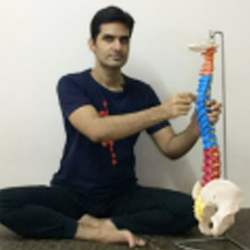
Yoga posture and alignment (details)
1) Introduction and concept
- Applied yoga anatomy
- Connective tissue and muscle role in movements
- Bones and joints function in movements
- Kinetic chain movements and their role in movements
2) Joint stability and mobility drills
- Wrist and elbows testing and assessments
- Injury prevention and corrective alignment for wrist and elbows in arm balancing and loading postures
- Palm stability and its importance in balance postures
- Wrist joint anatomy, health, function, and purpose
- Elbow joint anatomy, health, function, and purpose
- All related yoga postures to experience with muscle control including but not limited to crow pose, [peacock pose, pendant pose, high plank, reverse plank, upward-facing dog, downward-facing dog, and much more
3) Shoulder and scapula testing and assessments
- Injury prevention and corrective alignment for shoulders and scapula in arm balancing and loading postures
- Shoulder joint anatomy, health, function, and purpose
- Scapula blades anatomy, health, function, and purpose
- All related yoga postures to experience with muscle control including but not limited to Chaturanga, wheel pose, king pigeon, intense side stretch pose, cow facing pose, eagle pose, puppy pose, and much more
4) Cervical spine testing and assessments
- Cervical spine anatomy, health, function, and purpose
- Injury prevention and corrective alignment for neck joint in inversions and neck flexion or extension postures
- All related yoga postures to experience with muscle control including but not limited to plow pose, shoulder stand, ear pressure pose, fish pose, bridge pose, headstand, and much more
5) Thoracic and lumbar testing and assessments
- Thoracic spine anatomy, health, function, and purpose
- Lumbar spine anatomy, health, function, and purpose in backbends
- Injury prevention and corrective alignment for the thoracic and lumbar spine in backbends or extensions postures
- All related yoga postures to experience with muscle control including but not limited to locust pose, cobra pose, crocodile pose, bow pose, bridge pose, wheel pose, camel pose, upward-facing dog, low lunge backward bend, pigeon pose, backbend standing, and much more
6) Sacroiliac joint, lumbar, and Pelvis testing and assessments
- S. I. joint anatomy, health, function, and purpose
- Lumbar anatomy, health, function, and purpose in flexion or forward bends
- Pelvic anatomy, health, function, and purpose
- Injury prevention and corrective alignment for S.I. joint, lumbar, and Pelvic in forwarding bends
- All related yoga postures to experience with muscle control including but not limited to Marichi asana, twisting postures, revolved side angle, revolved triangle, revolved half-moon, supine spinal twists, standing twists, Paschimottanasana, Janusirsasana, Pawanmuktasana, Hanuman asana, wide-angle forwards fold, Uttanasana, and much more
7) Hip joint testing and assessments for all movements (flexion, extension, abduction,
adduction, internal and external rotation)
- Hip joint anatomy, health, function, and purpose
- Injury prevention and corrective alignment for the hip joint in all yoga postures
- All related yoga postures to experience with muscle control including but not limited to deer pose, Baddhakonasana, single-leg sitting balance pose, frog pose, Goddess pose, triangle pose, warrior one pose, warrior two pose, warrior three pose, side angle pose, and much more
8) Knees and feet
- Knee joint, ankle, and foot testing and assessments
- Knee joint anatomy, health, function, and purpose
- Ankle joint anatomy, health, function, and purpose
- Foot joint anatomy, health, function, and purpose
- Injury prevention and corrective alignment for the knee joint, ankle, and foot
- All related yoga postures to experience with muscle control including but not limited to Padmasana, Vajrasana, Veerasana, Tadasana, Trikonasana, Utkatasana, Veerbhadrasana one and two, high lunge, Supta Vajrasana, Malasana, tree pose, eagle pose, single-leg toe hold pose, and much more
VI. USAGE OF PROPS (Yoga block, yoga strap, Bolsters, Chairs and Blankets)
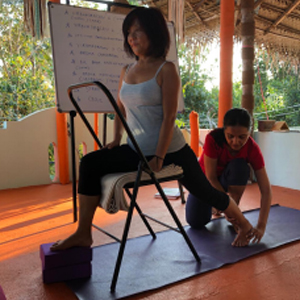 Yoga props are extremely useful in helping for creating sthira (steadiness) and sukha (comfort) in your yoga practice. By no means limited to beginners, props help to accommodate anatomical differences, tight muscles/joints, and limited ranges of motion. Props are also essential for opening up ‘stuck’ areas (we all have them!). If you’ve ever wondered how to efficiently use props in your home or studio practice, we provide an introduction to the accoutrements that could bring your asana practice, the union of body, mind, soul, and spirit.
Yoga props are extremely useful in helping for creating sthira (steadiness) and sukha (comfort) in your yoga practice. By no means limited to beginners, props help to accommodate anatomical differences, tight muscles/joints, and limited ranges of motion. Props are also essential for opening up ‘stuck’ areas (we all have them!). If you’ve ever wondered how to efficiently use props in your home or studio practice, we provide an introduction to the accoutrements that could bring your asana practice, the union of body, mind, soul, and spirit.
– Therapeutic purpose
– Restorative & Yin yoga
– Relaxation
– Inversions
– Hip, Chest & Shoulder Opening
– To address structural limitations
– Improved flexibility with Stability & Mobility
VII. Practicum
In this section, you will be slowly prepared to lead a yoga class yourself. In the beginning you will start to teach sun salutations and simple sequences to your fellow yogis. With your peers, you have learning and supporting each other in this yogic growth process. In the progress of your training, you will start to observe and correct each other, and finally practice teaching as the lead instructor and participate with others teaching as well. We value the process of learning and co-inspiring together as teachers and students – we can all learn and appreciate each other’s art of yoga.
We also highlight these crucial aspects to guide you as a professional yoga teacher:
- The Business of Yoga
- Teacher guidelines & etiquette
- Appropriate conduct inside and outside the yoga room
- How to apply for a teaching position
- Teacher expectations
- Student interaction
- Role playing
- Feedback
CONTINUING JOURNEY OF YOGA: Reflection on the process of becoming a yoga teacher.
 If you are aware of how to learn and how to teach, you will be capable of handling anything if given the right amount of time, motivation, and support. The basics of every subject matter is extremely important, for your foundations as well as what you pass onto students.
If you are aware of how to learn and how to teach, you will be capable of handling anything if given the right amount of time, motivation, and support. The basics of every subject matter is extremely important, for your foundations as well as what you pass onto students.
- Reflection on the Process of Becoming a Yoga Teacher & What makes a powerful teacher
- Discussion on what Certification Provides
- Code of Ethics
- Yoga Alliance Registration
- Group conversation about options for teaching and sharing
- Discussion about how to maintain appropriate skill and inspiration
QUALIFICATIONS:
Your graduation qualifies you to: ASSIST / TEACH / PRACTICE through Yoga Teacher Alliance
![]()
Daily Schedule
| Timetable : | |
|---|---|
| 6:15 – 6:30 | Kriyas & Cleansing(self- Practice) |
| 6:30 – 7:00 | Group Meditation |
| 7:00 – 9:00 | Pranayama & Yoga Asanas Practice |
| 9:00 | Breakfast & Break |
| 11:30 – 13:00 | Theory Class |
| 13:15 | Lunch & Break |
| 14:30 – 16:00 | Theory Class or Pranayama or Self- Study Time |
| 16:30 – 18:00 | Yoga Asanas |
| 18:30 | Dinner |
| 19:30 | Occasional Evening Program |
![]()
Our Teachers
◈ Shiva
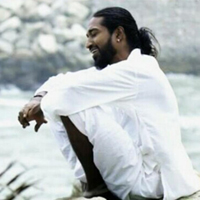
◈ Shalini

◈ Dr. Anish
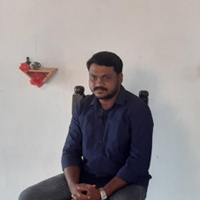
◈ Hardik Mehta
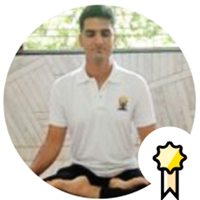
◈ Prutha Bhatt
